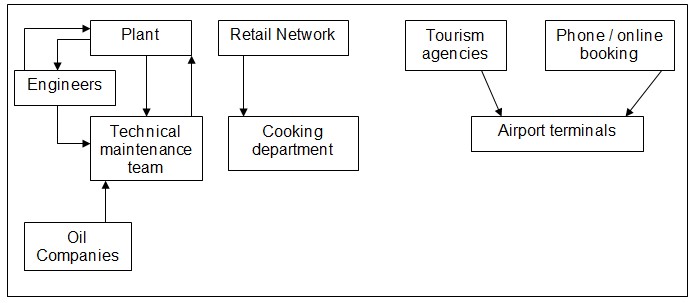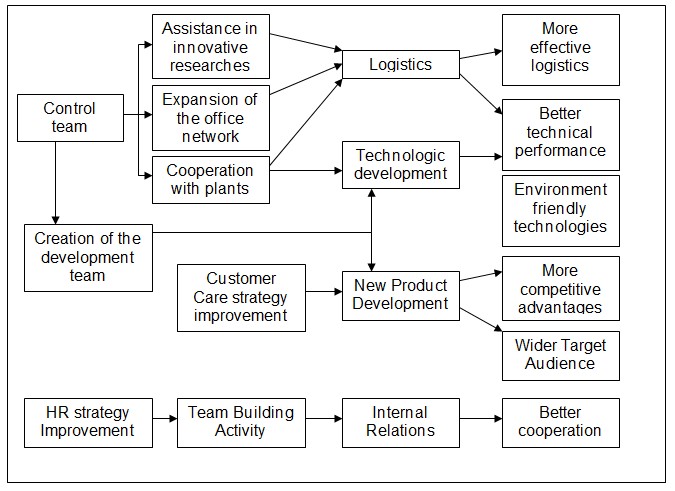Executive Summary
British Airways is regarded as one of the largest airline transporters in the world. (Dow, 2010) The business strategies applied by this company are effective, and checked by time, however, the company experiences essential difficulties in supply chain and logistics spheres. This is explained by the fact that the bureaucratic and conservative nature of managing the company creates sufficient barriers for effective problem solving in this sphere. (Dow, 2010) However, Just-in-time strategy helps the company to increase the effectiveness of the supply. (Christopher, 2010) The aim of the research is to analyze the supply chain principles, offer improvement steps, and create the implementation plan for bringing these projects to life.
This will require clear identification of the nature of services offered, and definition of the key problem spheres for improving the entire performance of the supply chain strategy, logistics, and related spheres. The report is aimed at offering improvements for logistics as is, technologic development of the company, development and implementation of the new products, as well as improving internal relations within the company. Therefore, it is stated that the regarded spheres are the basis of the effective business performance.
Current Operations and Supply Chain
Current supply chain operations performed by British Airways are closely linked with engineering works, research and development, and customer care. (Walking Tall: British Airways Tourism for Tomorrow Awards, 2003) These are required for proper development of business performance, improving technical basis of the company, and keep the required level of customer care quality. These practices help the company to stay agile on the global market, control the costs, quality of the services, increase business performance flexibility, and stay more competitive. (Boone and Ganeshan, 2004)
As for the costs, the company is not aimed at lowering the costs of the flight, and the key aim of the pricing policy is to offer high quality services for passengers. The company does not support the idea of low cost flights, as in accordance with the statement of economists Donald Bowersox, David Closs and Bixby Cooper (2009) this violates the entire principle of BA’s business performance strategy.
The company offers high quality services, and the key aim of these services is to provide safe, quick, and comfortable transportation for people and their luggage. Service factory involves generating the necessary circumstances for offering the high quality services, and the passengers should get the wide range of services, starting from booking a ticket, and ending with getting a candy on a board. (Kryda, 2007) This means that the personnel should be experienced, trained, and friendly with the customers, as communication may be regarded as the essential part of the services, and finding qualified, adequate, and trained personnel is the part of the supply chain system. The product that is offered is the part of the services: tickets, comfort, food that is served during the flight. On the one hand, it is hard to combine two types of process types, however, this may be regarded as one of the components of successful business activity and supply chain management performed by British Airways Company. (Simchi- Levi, Kaminsky, 2003)
Supply chain and current operations diagram (Figure 1) is based on the regular performance of the company in the sphere of airline transportation, and it should be emphasized that the actual importance of properly arranged supply chain defines the flexibility of the company on the market, and helps solving the problems associated with delays, business risks, technical problems, etc. (Christopher, 2010)
The entire supply chain management is performed through the central management department, the executives of which define the terms of the cooperation. Sandor Boyson and Lisa Harrington (2004) emphasize that this management model may be effective for crisis times only, therefore, in spite of the responsiveness, this undermines the opportunity of development and flexibility. Additionally, central office defines the terms and principles of business performance, as this is crucial for meeting the company’s requirements, standards, and aims. (Goodall, 2005)
Improvement Proposal
As it is stated by business analytic Greg Dow (2010) British Airways is regarded as one of the largest performers on the European market of airline transportation, however, there are numerous spheres that should be improved within the organization. Therefore, the company should improve the sphere of global logistics and supply chains, and improve the JIT system. Hence, it is emphasized in the case study by Celerant Consulting (2004, p.1 ) that the company experiences difficulties in avionics and spare parts supply:
Systems, processes, and people: British Airways Engineering supplies aircraft maintenance and repair services to British Airways. The company directly supports over 300 British Airways and alliance aircraft and provides turnaround support and other services for over 100 customer airlines. With continuing pressure to reduce cost and spending, slow component repair turnaround times were resulting in artificially elevated inventory levels and inconsistent service. (Celerant Consulting, 2004, p.1 )
In accordance with the research by Georgine Kryda (2007) The only way to improve the situation is to increase the management control level, for the technical maintenance teams had an opportunity to communicate with the executives responsible for this part of business performance.
Another sphere is the technology development. In accordance with the statement by analytic Georgine Kryda (2007), British Airways Company is not involved into the problem of environmental protection, and is reluctant for implementing environment friendly technologies. The most reliable and effective solution tool will be cooperation with Virgin Airways that is deeply involved into environment friendly researches for improving airplane engines. However, considering the previous instances of unfair competition, and poor relations with this company, BA may have another competitive point for confirming its interest in the global development, and reducing costs for airline transportation. in accordance with the statement of economists Donald Bowersox, David Closs and Bixby Cooper (2009) this reduction is explained by the fact that friendly engines consume less fuel, and produce lower CO and CO2 emissions. Therefore, the company should invest into development of new technologies, and support the global initiative that has been already maintained by its competitors.
New product development may be closely linked with the previously described problem, however, it should be stated that the company needs to care of the additional services for passengers. Conservative nature of service management is the key barrier for implementing these services, hence, there is a need to add multimedia services for passengers, the company needs to improve on-line and phone ticket booking system for attracting more youth. (Dow, 2010) Finally, there is a need to consider the opportunity of fire safety and terrorism protection systems for increasing the safety and comfort of passengers.
Inter-organizational relationships may be regarded as the crucial aspect for improving the entire performance of the company. Proper inter-organizational relations will contribute to the previously stated problems, as more harmonious and coordinated relations will mean higher effectiveness of the business performance, while this may be regarded as the basis of further improvements. (Walking Tall: British Airways Tourism for Tomorrow Awards, 2003) In general, the business improvement tools that may be required for the successful implementation of the regarded projects are based on the coordinated and properly arranged work of the team, while in accordance with the research by business researchers Sandor Boyson and Lisa Harrington (2004) BA CEO is too conservative and even prejudiced for cooperating with Virgin Atlantic, and for implementing too daring projects.
Implementation Plan
The implementation of the regarded projects will be based on the properly developed action plan, as well as precise coordination of the efforts, as it has been emphasized. (Bowersox, Closs and Cooper, 2009) The network diagram (Figure 2) offers the key direction for project implementation and development.
Human resources that will be needed for the implementation plan involve Control team, Development team, and HR team:
The first should consist of experienced managers that are able to control the implementation of the project, and experienced negotiators that will head the cooperation process with the plants. The costs of this part involve communication and presentations if the negotiations are performed in conservative style. Improved logistics and technical performance will compensate these costs. (Christopher, 2010)
Development team should involve experienced analytics, and idea generators for originating small improvement projects. The brightest examples of these projects may be the multimedia panel on each seat, launch of an experimental low cost campaign, offering special services on board like a nurse for passengers with kids, or small kinder garden on board. (Dow, 2010) The costs of this project are associated with training the required personnel, developing the invented projects, and implementing the created strategies into the business process.
HR Team should be creative and daring. Team building activity is the double end stick, as improperly suited strategy will inevitably worsen the situation. Therefore, the company will have to employ the necessary specialists, and train the HR team for implementing team building projects. (Kryda, 2007) Therefore, the team building process will become a part of logistics, and will help to improve the JIT principles by increasing the reliance of the team workers on each other. Since this is one of the key factors of improvement, HR management team will have to perform effective measures for studying the inter relations within the teams.
Reference List
Boone, T. & Ganeshan, R. (Eds.). 2004. New Directions in Supply-Chain Management: Technology, Strategy, and Implementation. New York: AMACOM.
Bowersox, D., Closs, D., Cooper, B. 2009. Supply Chain Logistics Management. McGraw-Hill Higher Education 3rd ed.
Boyson, S., Harrington, L. H.,. 2004. In Real Time: Managing the New Supply Chain. Westport, CT: Praeger.
Celerant Consulting. 2004. British Airways Engineering Charts, supply chain change. Web.
Christopher, M. 2010. Logistics and Supply Chain Management: Creating Value- Adding Networks. Financial Times/Prentice Hall 4th ed.
Dow, G. 2010. British Airways: Flying into the Field. Geographical, 77, 101.
Goodall, B. 2005. Environmental Auditing: A Tool for Assessing the Environmental Performance of Tourism Firms. The Geographical Journal, 161(1), 29.
Kryda, G. M. 2007. The Competition Criterion in British Merger Control Policy. Policy Studies Journal, 30(2), 252.
Simchi- Levi, D., Kaminsky, P., 2003 Managing the Supply Chain: The Definitive Guide for the Business Professional. McGraw-Hill.
Walking Tall: British Airways Tourism for Tomorrow Awards. (2003). Geographical, 75, 99.
Appendix

